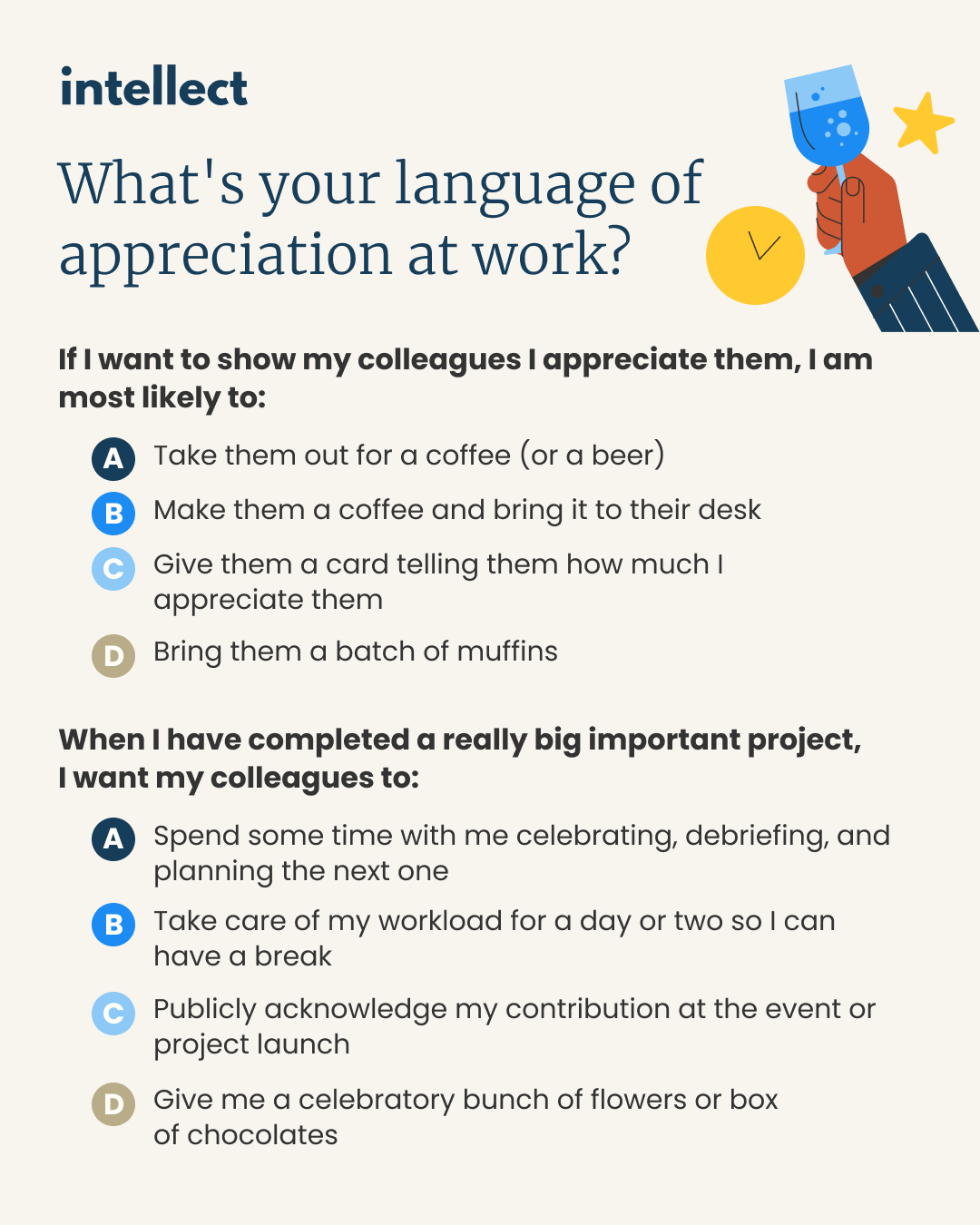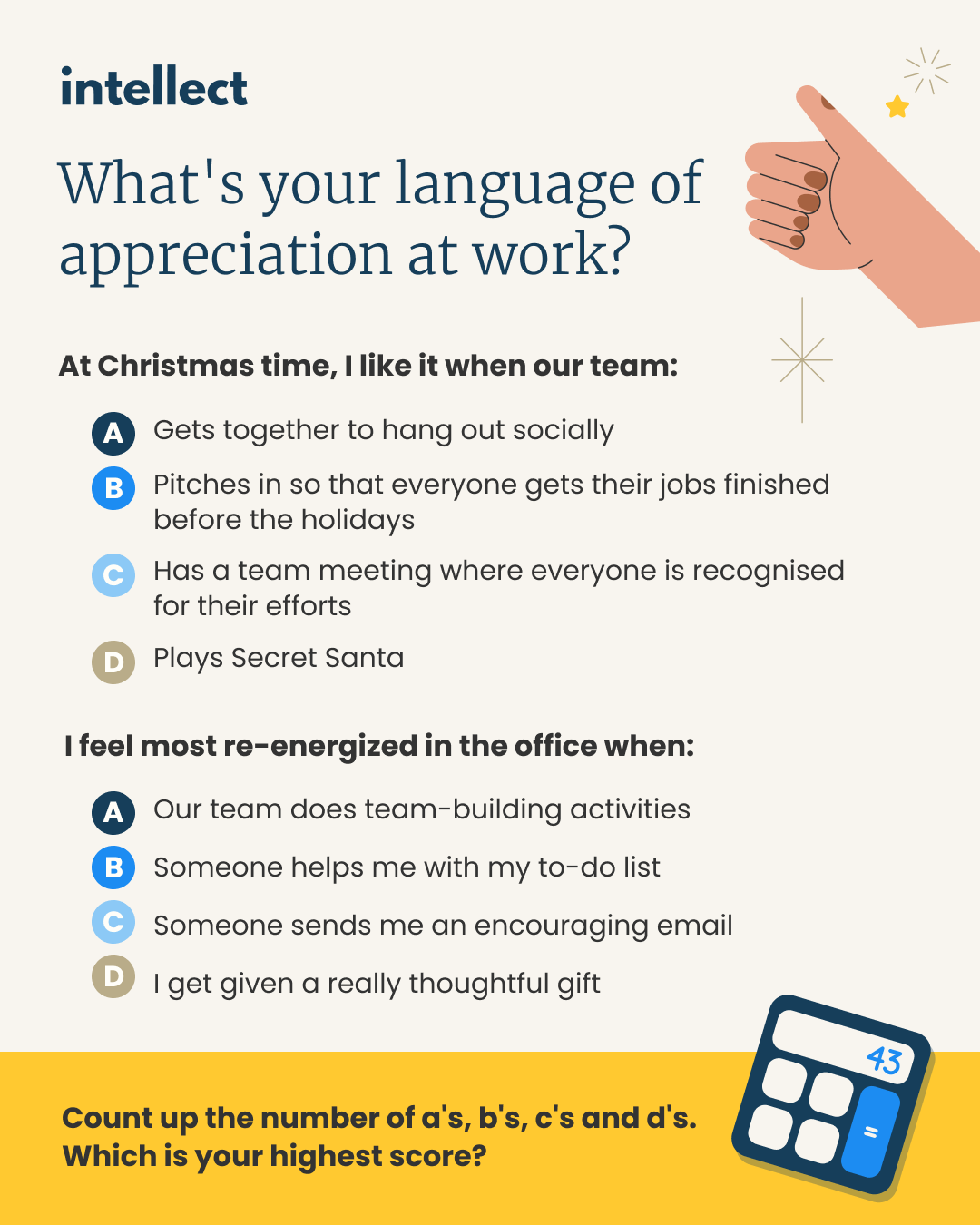This article was contributed by Intellect’s behavioural health coach Dr Jordan Alexander. She is an international best-selling author, the CEO of Love Assist Associates, and an ICF-accredited practitioner with decades of experience in workplace strategy and leadership.
Okay, I see the eye rolls. Love in the workplace, really? What’s next? But let me ask: would you like your team to show up at work enthusiastically and operate the business as if they own it? Okay, then you’re going to love today’s topic: how to motivate employees.
Obviously, employee motivation and organisational success are directly correlated. However, that some people bounce out of bed in the morning while others hit the snooze button makes it hard to define. Purpose may have been cited as a priority among millennials, but is that the case for the fifty-somethings in your team?
Figuring your employees out takes time – they may not have the answers themselves – but appreciation serves as a gateway to employee motivation. Appreciation is shown and felt in everyday interactions, but what makes an individual tick may very well put another off. You may feel seen when commended publicly for a job well done, but your colleague may cringe at being put on display.
In this article, we will discuss employee motivations and how to speak in your team members’ “languages of appreciation”. But first, let’s look at the former has evolved and its implications in the post-pandemic workplace.
Has “meaning” overtaken “security”?

Would you work for free? Isn’t motivation just about money?
Life for leaders would be simple if financial rewards were the only staff motivator. While money does matter, it doesn’t top the list. According to a 2019 Hays Recruitment survey, only 13% of job seekers were dissatisfied with their salary and benefits. The majority (40%) desired a job change “because it’s time” or sought progression or more training (22%).
When it comes to motivation, there is no silver bullet. So how can leaders and organisations ensure they reap the benefits of highly motivated staff? Let’s explore the main drivers of motivation before diving into the love language pool.
How employee motivations have shifted
The good old Maslow’s hierarchy of needs introduced security as the most basic human need and self-actualisation as the pinnacle in the 1940s. Building upon this work, Harvard professor David McClelland later identified three human motivations in the 1960s: achievement, affiliation, and power. Now, in the 21st century, organisations need to adopt a still broader perspective on employee motivation. In 2016, IBM’s Smarter Workforce Institute (2016) identified meaningful work as the biggest contributor to positive workplace practices.
We are living in turbulent times, as the trendy VUCA (volatile, uncertain, complex, and ambiguous) acronym reminds us. Post-COVID-19, expectations surrounding diversity, job security, and loyalty are changing. New motivations, such as feeling a sense of purpose and connection to the work we do, have emerged.
According to Harvard Business Review,
- More than 9 in 10 workers would be willing to earn less money for the opportunity to engage in more meaningful work.
- Among millennials, 57% have expressed that having a positive impact on the world through their work is very important.
What drives employees today

For ease of implementation, I have distilled the above into the five motivations below. When translating theory into practice and policies, I encourage your organisation to consider which lexicon best aligns with your employer brand.
Managers can also use their understanding of intrinsic and extrinsic motivations and use their understanding of intrinsic and extrinsic motivations when providing feedback or incentivising performance. An affirmative appraisal may work for an intrinsically motivated person, whereas strategic reward structures may suit employees who are extrinsically motivated.
(As a parent, I often think about the differences between intrinsic and extrinsic motivations this way: if you play a sport or read a book because you enjoy it, you are intrinsically motivated. If you want to win the trophy in sport, or get the top grade in class for reading the book, you are extrinsically motivated.)
Enjoy exploring them – the value lies in the discussion of “what matters” to you and your people.
1. Quality Lifestyle
This intrinsic driver encompasses various aspects, ranging from “security” in terms of fair, adequate, and timely compensation to meet basic human needs, to maintaining a healthy work-life balance as per your individual definition. It is important to be mindful that what holds significance to you can evolve at different stages of life and career.
2. Rewards & Recognition
This extrinsic driver fulfils one’s “need for power,” a motivator identified by McClelland. It encompasses the desire for success, respect, esteem, and recognition from peers or leadership. Examples of this driver include job titles and public acknowledgement for one’s efforts, provided you check with the intended recipient first. For instance, I work with a number of Pasifika clients who would feel embarrassed by public recognition but would appreciate one-to-one praise.
3. Opportunity
Access to new challenges and opportunities captures the need for self-actualisation in Maslow’s model. Individuals who are intrinsically motivated by achieving their full potential are usually open to building new capabilities, taking on new projects, and exploring new ways of working. Managers can keep an eye out for opportunities to scratch their itch to learn.
4. Ownership
Employees with a sense of ownership are fully engaged, take responsibility for their work and its impact, and treat the company as if it’s their own. They are driven by achievement (McClelland) and even thrive on a bit of competition.
An entrepreneurial vibe comes into play here as these employees are often proactive, innovative, and driven to do what is right. Ownership fosters accountability and trust, serving as the ultimate motivator for successful organisations.
5. Affiliation
Affiliation captures the notion of meaningful work, which has been highlighted more recently by Harvard Business Review. It combines individual purpose with a sense of belonging and connection. Affiliation contributes to one’s identity and fosters the spirit of “we’re all in this together”, thus encompassing both intrinsic and extrinsic dimensions.
Motivation approaches, though backed by science, are more an art when it comes to implementation, so be patient in figuring out what drives every team member. It’s for this reason I use the following tool to get the ball rolling within teams and communicate in a consistent language at the group level.
The five languages of appreciation

You were concerned I had forgotten about love, but fear not. We’ve saved the best for last.
You may be familiar with Gary Chapman’s “5 Love Languages,” which categorises our preferences when giving and receiving love in personal relationships. We connect more effectively when we understand which of the five groups apply to our partner, friend, or family member. Chapman has since applied this to the modern office, co-authoring “The 5 Languages of Appreciation in the Workplace” with Dr. Paul White.
You may think: our employee engagement scores are high, so my team must feel appreciated. Well, I’d wait to put my money on that bet. Studies have shown that while 79% of workers feel somewhat or very engaged with their current employer, 80% feel their employer could be doing more to show appreciation. Reasons for not feeling appreciation range from a lack of support (46%) to a lack of recognition (44%), which is especially an issue for remote workers who aren’t around to receive impromptu feedback in person.
This is where the five languages of appreciation come in. We’ve ranked them according to popularity among employees and included handy tips to start incorporating them in communication.
1. Words of Affirmation
This is the most popular (47%) language of appreciation and can work particularly well for employees who are driven by recognition. It may involve offering compliments, expressing gratitude, or acknowledging the value of their efforts or contributions. Again, remember to check whether this should be done in private or in a team environment – it matters!
Pro-tips:
- Don’t wait for formal performance reviews. Make it a habit to give praise when you notice someone’s effort.
- Instead of generic compliments, highlight specific actions, qualities, or achievements.
- If you aren’t the most expressive person, try post-its, emails, or digital platforms. A well-crafted message can be revisited by the recipient when, say, imposter syndrome creeps in.
2. Quality Time
This is popular for 26% of the workforce and emphasises focused attention, meaningful conversations, and social activities. Employees driven by affiliation are likely to find this particularly valuable.
Pro-tips:
- Listen actively and respond empathetically to demonstrate that you value their input.
- Show support for their professional growth by attending conferences, workshops, or training sessions in which they are involved.
- Schedule regular one-on-one and mentoring sessions to discuss their goals and provide feedback.
3. Acts of Service
Helping one another is important to 22% of the workforce. Appreciation is felt when a colleague goes the extra mile to assist them or takes on tasks that alleviate their workload. For example, a manager could allow a team member with caregiving duties to work from home so they can maintain some semblance of work-life balance (see: quality lifestyle).
Pro-tips:
- Offer to get coffee or a sandwich for a colleague who is stuck in a meeting during lunch.
- Be flexible with work schedules, personal needs, or other obligations the employee may have.
- Provide resources that can help them with their work. For example, employees driven by opportunity may appreciate coaching as a tool for self-improvement.
4. Tangible Gifts
Only 6% of the workforce identifies this as their primary language. While some employees are driven by rewards, you can leave the diamond tennis bracelet at home, as gifts can be small gestures such as a personalised card or a book by their favourite author.
Pro-tips:
- Acknowledge milestones, birthdays, and work anniversaries with a token of appreciation.
- Get to know their preferences, hobbies, and interests, or consider gift cards and vouchers if you are unsure.
- Better yet, involve the employee in the gift selection process by giving them options.
5. Appropriate physical touch
This language has been in and out of fashion over the past few years, but since many cultural norms have physical elements, you just need to confirm what works for your team. High-fives, fist bumps, or a hand on their shoulder to reinforce a verbal message could be appropriate, but check with your team (I’m a hugger and just ask first).
A quiz to get started
Not sure how to start the conversation about personal motivation? Here are a few quiz questions I use to identify my team’s languages of appreciation. I encourage you to try them with your team and modify them as needed to fit your situation. You can use the data gathered during one-on-one meetings to initiate conversations and begin uncovering the personal motivations of each individual. The sooner you start, the better you’ll understand your team.



By understanding what motivates the modern workforce and embracing the concept of “love languages” in the workplace, we have developed a new game plan for employee engagement. However, it is important to recognize that appreciation alone is not enough, and expecting HR staff or managers to bear the entire responsibility is disproportionate.
To truly support employee wellbeing in a holistic manner, we need to explore end-to-end solutions. One such solution is Intellect, which offers a range of resources to support both people managers and individual contributors.
With a panel of behavioural health coaches, counsellors, and therapists, Intellect provides comprehensive support for the mental and emotional wellbeing of your workforce. Recently, the platform has expanded its offerings to to include:

Learn more about adopting Intellect for your organisation here.








